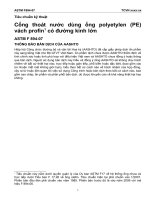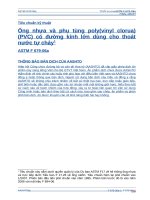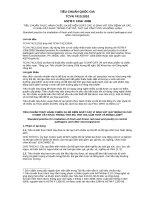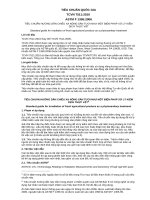Astm f 1966 12
Bạn đang xem bản rút gọn của tài liệu. Xem và tải ngay bản đầy đủ của tài liệu tại đây (95.91 KB, 5 trang )
Designation: F1966 − 12
An American National Standard
Standard Specification for
Dough Divider and Rounding Machines1
This standard is issued under the fixed designation F1966; the number immediately following the designation indicates the year of
original adoption or, in the case of revision, the year of last revision. A number in parentheses indicates the year of last reapproval. A
superscript epsilon (´) indicates an editorial change since the last revision or reapproval.
2.3 BISSC Standards: 4
Basic Criteria
No. 8 Dividers, Rounders, and Bun Machines
No. 29 Electrical Motors and Accessory Equipment
2.4 NEMA Standards: 5
MG 1 Motors and Generators
WC 5 Thermoplastic—Insulated Wire and Cable for the
Transmission and Distribution of Electrical Energy
WC 7 Cross-Linked-Thermosetting-Polyethylene-Insulated
Wire and Cable for the Transmission and Distribution of
Electrical Energy
WD 1 General Requirements for Wiring Devices
2.5 NSF/ANSI Standards: 6
NSF/ANSI No. 2 Food Equipment
NSF/ANSI No. 8 Commercial Powered Food Preparation
Equipment
NSF/ANSI No. 51 Food Equipment Materials
NSF/ANSI No. 169 Special Purpose Food Equipment and
Devices
2.6 ANSI/UL Standards: 7
ANSI/UL 763 Motor-Operated Commercial Food Preparing
Machines
ANSI/UL 969 Marking and Labeling Systems
2.7 Federal and Military Documents: 8
MIL-STD-1399/300 Interface Standard for Shipboard Systems Section 300A Electric Power, Alternating Current
MIL-STD-167/1 Mechanical Vibrations of Shipboard
Equipment (Type I—Environmental and Type II—
Internally Excited)
MIL-STD-461 Requirements for the Control of Electromagnetic Interference Characteristics of Subsystems and
Equipment
1. Scope
1.1 This specification covers commercial hand operated
dough divider machines and semiautomatic and automatic,
electrically operated, dough divider and rounding machines
with or without interchangeable heads.
1.2 The values stated in inch-pound units are to be regarded
as standard. The values given in parentheses are mathematical
conversions to SI units that are provided for information only
and are not considered standard.
1.3 This standard does not purport to address all of the
safety concerns, if any, associated with its use. It is the
responsibility of the user of this standard to establish appropriate safety and health practices and determine the applicability of regulatory limitations prior to use.
2. Referenced Documents
2.1 ASTM Standards:2
A167 Specification for Stainless and Heat-Resisting
Chromium-Nickel Steel Plate, Sheet, and Strip
A240/A240M Specification for Chromium and ChromiumNickel Stainless Steel Plate, Sheet, and Strip for Pressure
Vessels and for General Applications
D3951 Practice for Commercial Packaging
F760 Specification for Food Service Equipment Manuals
F1166 Practice for Human Engineering Design for Marine
Systems, Equipment, and Facilities
2.2 ANSI Standards: 3
Z1.4 Sampling Procedures and Tables for Inspection by
Attributes
1
This specification is under the jurisdiction of ASTM Committee F26 on Food
Service Equipment and is the direct responsibility of Subcommittee F26.04 on
Mechanical Preparation Equipment.
Current edition approved Nov. 1, 2012. Published December 2012. Originally
approved in 1999. Last previous edition approved in 2008 as F1966 – 03 (2008).
DOI: 10.1520/F1966-12.
2
For referenced ASTM standards, visit the ASTM website, www.astm.org, or
contact ASTM Customer Service at For Annual Book of ASTM
Standards volume information, refer to the standard’s Document Summary page on
the ASTM website.
3
Available from American National Standards Institute (ANSI), 25 W. 43rd St.,
4th Floor, New York, NY 10036.
4
Available from Baking Industry Sanitation Standards Committee (BISSC),
1400 W. Devon Ave., Suite 422, Chicago, IL 60660.
5
Available from Global Engineering Documents, 15 Inverness Way East,
Englewood, CO 80112-5704
6
Available from NSF International, P.O. Box 130140, 789 N. Dixboro Rd., Ann
Arbor, MI 48113-0140.
7
Available from comm2000, 1414 Brook Dr., Downers Grove, IL 60515.
8
Available from Standardization Documents Order Desk, Bldg. 4 Section D, 700
Robbins Ave., Philadelphia, PA 19111-5094, Attn: NPODS.
Copyright © ASTM International, 100 Barr Harbor Drive, PO Box C700, West Conshohocken, PA 19428-2959. United States
1
F1966 − 12
5.1.7 When specified, the purchaser shall be furnished
certification that samples representing each lot have been either
tested or inspected as directed in this specification and the
requirements have been met. When specified, a copy of the test
results shall be furnished.
5.1.8 Level of preservation and packing required if other
than as stated in Practice D3951 (see 17.1),
5.1.9 Labeling requirements (if different than 15.1), and
5.1.10 Whether the equipment shall meet the requirements
of ANSI/NSF, ANSI/UL, or BISSC standards, or a combination thereof.
3. Terminology
3.1 Definitions:
3.1.1 recovered materials—materials that have been collected or recovered from solid waste and reprocessed to
become a source of raw materials, as opposed to virgin raw
materials.
4. Classification
4.1 General—Dough dividers and dough divider/rounding
machines covered by this specification are classified by type
and size.
6. Material
4.2 Type:
4.2.1 Type I—Dough divider machine, manually operated,
4.2.2 Type II—Dough divider and rounder, semiautomatic,
electrically operated,
4.2.3 Type III—Dough divider and rounder, fully-automatic,
electrically operated, and
4.2.4 Type IV—Dough divider machine, fully-automatic,
electrically operated.
6.1 General—Dough divider, and dough dividing and
rounding machines shall conform to NSF/ANSI No. 8 or
BISSC Basic Criteria and Standard No. 8. Materials used shall
be free from defects that would affect the performance or
maintainability of individual components or of the overall
assembly. Materials not specified herein shall be of the same
quality used for the intended purpose in commercial practice.
Unless otherwise specified herein, all equipment, material, and
articles incorporated in the work covered by this specification
are to be fabricated using materials produced from recovered
materials to the maximum extent possible without jeopardizing
the intended use. None of the above shall be interpreted to
mean that the use of used or rebuilt products are allowed under
this specification unless otherwise specified.
6.1.1 Stainless Steel: Stainless steel shall conform to the
300 series of Specification A167 or A240/A240M as applicable.
4.3 Class:
4.3.1 Class I—Fixed head,
4.3.2 Class II—Fixed variable head, and
4.3.3 Class III—Interchangeable head.
4.4 Size:
4.4.1 Size 1—36-part dough divider (part sizes up to 4 oz
(113.4 g)),
4.4.2 Size 2—18-part dough divider machine (part sizes 2 oz
up to 6 oz (56.7 to 170.1 g)), and
4.4.3 Size 3—Fixed and interchangeable head assemblies
that may include the following approximate ranges of part by
weight:
36-part
18-part
9-part
6-part
1
3
7
1
7. Design and Construction
7.1 General—Dough divider and rounding machines shall
be delivered assembled, ready for mounting, connection to
electricity, and use as applicable.
oz up to 3 oz (28.4 g up to 85.2 g)
oz up to 7 oz (85.2 g up to 199 g)
oz up to 1 lb 2 oz (199 g up to 510.3 g)
lb 2 oz up to 1 lb 10 oz (510.3 g up to 737.1 g)
7.2 Dough Divider—The Type I machine shall consist of a
base, an operating handle, a manually operated dough dividing
mechanism (cutting head with stainless steel knives or other
material meeting NSF/ANSI No. 51 or BISSC Basic Criteria
and Standard No. 8 requirements, and pressure board meeting
the same material requirements), a yoke or support, and a
removable dough pan. The base of the Type I machine shall be
provided with bolt holes for mounting. The overall dimensions
of the machine, excluding operating handle, shall fit into a 17
in. (423 mm) by 18-1⁄2 in. (470 mm) square area, 22-1⁄2 in. (565
mm) in height, 63 in. (76.2 mm) for each dimension.
7.2.1 Pan—The Type I machine shall be provided with a
circular dough pan of one piece, deep drawn stainless steel or
other material meeting NSF/ANSI 51 or BISSC Basic Criteria
and Standard No. 8 requirements. The pan shall be readilyremovable and shall have not less than one handle.
4.4.4 This specification does not purport to address all of the
sizes that may be available, but is an overview of the most
common sizes used in the industry today (see Appendix X1).
4.5 Style:
4.5.1 Style 1—Countertop or bench mounted,
4.5.2 Style 2—Floor mounted, and
4.5.3 Style 3—Portable.
5. Ordering Information
5.1 Ordering Data—Purchasers shall select the dough divider and rounding machine and any preferred options and
include the following information in the purchasing document:
5.1.1 Title, number, and date of this specification,
5.1.2 Type, class, size, and style of machine required,
5.1.3 Quantity to be furnished,
5.1.4 Electrical power supply characteristics: voltage,
phase, frequency (see 7.4.1),
5.1.5 Accessory equipment, number of heads, options, spare
parts, and maintenance parts required,
5.1.6 When Federal/Military procurement is required, review and implement the applicable supplementary requirements (see S1 through S9),
7.3 Dough Divider and Rounder—The Type II machine
shall be semiautomatic consisting of a floor mounted support or
stand with integral housing, a manually operated dough divider
mechanism (cutting head with stainless steel knives or other
material meeting NSF/ANSI No. 51 or BISSC Basic Criteria
and Standard No. 8 requirements, and pressure board meeting
the same material requirements), an electric motor operated
2
F1966 − 12
burrs, slivers, tool and grind marks, dents, and cracks.
Castings, molded parts and stampings shall be free of voids,
sand pits, blow holes, and sprues. External surfaces shall be
free from kinks, dents, and other deformities. Forming and
welding shall not cause damage to the metal and shall be done
neatly and accurately.
rounding mechanism (rounder plate), a yoke or support, and a
removable work pallet. The Type II machine shall divide the
dough by manual operation and shall round the dough by an
automatic operation. The handle shall be fully depressed
manually to engage the rounding mechanism for the rounding
operation. The return of the handle shall disengage the rounding mechanism. The Type III machine shall be similar in
operation to the Type II machine with the exception that the
Type III machine is completely automatic, dividing and rounding dough automatically. The base of the Type II and III
machines shall be provided with bolt holes for floor mounting.
The overall dimensions of the Type II and III machines
excluding operating handle, shall fit into a 27 in. (686 mm) by
27 in. (686 mm) square area, 59 in. (1499 mm) in height, 62
in. (51 mm) for each dimension.
7.3.1 Rounder Plate and Work Pallets—Type II and III
machines shall have a rounder plate and four work pallets
constructed of stainless steel or other material meeting NSF/
ANSI No. 51 or BISSC Basic Criteria and Standard No. 8
requirements. The rounder plate shall be attached to and driven
by an electric motor as specified herein. The pallets shall have
recesses of a number corresponding to divider head assembly
divisions, embossed on each work pallet for forming the rolls
during rounding operation. The pallet design and recesses shall
meet NSF/ANSI construction requirements or BISSC Standard
No. 8 requirements, or both. Each pallet shall have one handle
and shall rest in a fixed position on the rounder plate during
operation. Work pallets shall be removable.
10. Sampling
10.1 A representative production model shall be selected for
performance testing.
10.2 When specified in the contract or purchase order,
sampling for inspection shall be performed in accordance with
ANSI Z1.4.
11. Test Methods
11.1 Operational Test—The dough divider and rounder
machine shall be operated, without a load, for not less than 25
cycles and meet the following requirements as applicable.
Inability of the machine to operate as specified herein shall
constitute failure of the test.
11.1.1 Proper operation of motor starting and stopping
devices,
11.1.2 Proper operation of adjusting and operating devices,
11.1.3 Proper operation of parts,
11.1.4 No overheating of bearings, and
11.1.5 No binding.
11.2 Performance Test—The dough divider and rounder
machine shall be operated to perform the dough dividing and
rounding operation on a pan/pallet of dough into separate and
equal pieces by weight 65 %, depending upon the amount of
whole dough placed in the dough pan/pallet and size of the
machine. Inability of the machine to operate as specified herein
shall constitute failure of the test.
7.4 Electrical Requirements:
7.4.1 Nominal Input Power—Unless otherwise specified
(see 5.1.4), the machine shall be designed to operate on one of
the following:
7.4.1.1 120 V, 60 Hz, single phase,
7.4.1.2 240 V, 60 Hz, single phase,
7.4.1.3 208 V, 60 Hz, three phase, or
7.4.1.4 220 V, 60 Hz, three phase.
7.4.2 Motor—The electric motor used on the semiautomatic
and automatic machines shall be a capacitor type or splitphased type and shall conform to NEMA MG 1 and BISSC No.
29. The motor shall be of sufficient horsepower and speed to
meet the production capacity. The motor shall have thermal
overload protection of the manual reset type.
7.4.3 Electrical Components—Unless designed for permanent electrical connection, these machines shall be provided
with a cord and plug meeting the requirements of ANSI/UL
763, and the plug shall conform to the appropriate NEMA WD
1 configuration. The cord shall extend not less than 5 ft (1.52
m) outside the machine. Wiring shall be in accordance with
NEMA WC 5 or NEMA WC 7.
12. Inspection
12.1 End Item Testing—When specified in the contract or
purchase order, one production item, selected at random from
each lot, shall be tested by the manufacturer in accordance with
the applicable paragraphs of Section 11. Performance results
shall be recorded in a permanent file, and the information shall
be available to the customer upon demand. Any subsequent
change in design that would relate to performance shall require
a new test record.
12.2 Component and Material Inspection—Incoming components and materials shall be inspected by the manufacturer to
the design parameters as specified on drawings or purchase
documents, or both.
13. Rejection and Rehearing
13.1 Material that fails to conform to the requirements of
this specification may be rejected. Rejection should be reported
to the producer or supplier promptly and in writing. In case of
dissatisfaction with the results of the test, the producer or
supplier may make claim for a rehearing.
8. Performance Requirements
8.1 When tested in accordance with Section 11, the dough
divider and rounder shall operate without failure of the major
functional components.
14. Certification
14.1 When specified in the purchase order or contract, the
purchaser shall be furnished certification that samples representing each lot have been either tested or inspected as directed
9. Workmanship, Finish, and Appearance
9.1 All components and assemblies of the dough divider and
rounder shall be free from dirt and other extraneous materials,
3
F1966 − 12
in this specification and the requirements have been met. When
specified in the purchase order or contract, a report of the test
results shall be furnished (see 5.1.7).
required by UL and NSF or BISSC as applicable, shall appear
on the identification plate. The plate shall be located on an
external surface.
15. Product Marking
16. Manuals
15.1 Each dough divider and rounding machine shall be
provided with an identification plate securely affixed to the
item. The plate shall be molded, die-stamped, etched on metal,
or an ANSI/UL 969 Recognized label material. The marking
shall be durable and shall be legible and readily visible after the
item is installed in the intended manner. The identification
plate shall include the name, brand, or trademark of the
manufacturer of such known character to be readily traceable
to the manufacturer and shall state the electrical characteristics
(voltage, amperage, and frequency) of the equipment. The
plate shall also bear a distinctive number, letter or number, and
letter code that will identify an individual item or production
lot of a limited group of items. In addition, such information
16.1 Format and content of applicable manuals shall be as
indicated in Specification F760.
17. Packaging and Package Marking
17.1 Unless otherwise specified (see 5.1.8), the complete
dough divider and rounder machine shall be packaged and
marked in accordance with Practice D3951. In addition, the
package shall be marked showing the model number, serial
number, and manufacturer’s name.
18. Keywords
18.1 appliance; bakery equipment; dough divider; dough
rounder; food service equipment
SUPPLEMENTARY REQUIREMENTS
FEDERAL AND MILITARY PROCUREMENT
S1. The supplementary requirements that follow apply to all
Federal and Military procurements. Where provisions of this
supplement conflict with the main body of this specification,
this supplement shall prevail.
ASTM ______
XX
XX
XX
XX
(ASTM Designation)
(Type)
(Class)
(Size)
(Style)
The above is an example of the PIN for an item in
accordance with ASTM Standard F1966–03, Type XX, Class
XX, Size XX, Style XX.
S2. Manual—A manual complying with Specification F760
and its supplement shall be provided.
S3. First Article Inspection—When required, the first article
inspection shall be performed on one unit. The first article may
be either a first production item or a standard production item
from the supplier’s current inventory, provided the item meets
the requirements of this specification and is representative of
the design, construction, and manufacturing technique applicable to the remaining items to be furnished under the contract.
S6. Human Factors Criteria—Human factors engineering
criteria, principles, and practices, as defined in Practice F1166,
shall be used in the design of all dough dividers and rounders.
S7. Preservation, Packaging, and Package Marking—
When other than commercial practice or conformance to
Practice D3951 is desired, the preservation, packaging, and
package marking requirements shall be stated in the purchase
order or contract.
S4. Label Plates—Dough dividers and rounding machines
shall be provided with data-name plates and instruction plates.
S4.1 Data-Name Plates—In addition to the manufacturer’s
data plate, machines shall be provided with data-name plates
readily visible to the operator during normal operating use and
so as to not adversely affect the life and utility of the unit.
Plates shall be attached to the front of the unit in such a manner
as to meet the applicable NSF International or BISSC sanitation requirements for this equipment. The plate shall contain
the following information: National Stock Number and Government Approved Manual Number.
S4.2 Instruction Plate—An instruction plate shall be made
of corrosion resisting metal or an ANSI/UL 969 Recognized
label material and shall be attached to the front of the dough
dividing and rounding machine. The instruction plate shall bear
instructions for startup, operation, and shutdown.
S8. Manufacturer’s Certification—If the manufacturer has
successfully furnished the same equipment on a previous
contract within the past three years, further inspection shall not
be required. The manufacturer shall certify in writing that the
equipment to be furnished is the same as that previously
furnished and approved, and that no major design changes have
been made to the equipment.
S9. Naval Shipboard Requirements—The following additional requirements apply when equipment is to be used for
shipboard purposes.
S9.1 Power Compatibility—Unless otherwise specified (see
5.1), dough divider and rounder machines shall be compatible
with 115 Vac, 60 Hz, single phase, alternating current for
shipboard as specified in MIL-STD-1399/300.
S9.2 Access—Dough dividers and rounding machines for
naval surface vessels shall pass through a 26 in. (660 mm) wide
by 66 in. (1676 mm) shipboard hatch without major disassembly. Machines for submarines shall pass through a 25 in. (635
S5. Part Identifying Number—The following part identifying numbering procedure is for government purposes and does
not constitute a requirement for the contractor. The PINs to be
used for items acquired to this document are created as follows:
4
F1966 − 12
ships and submarines. The first article or the initial production
unit, as applicable, shall be tested. The contractor shall furnish
written certification that the equipment meets the requirements
of MIL-STD-461. Nonconformance with the requirements
specified shall constitute failure of the test.
S9.6.2 Inclined Operational Test—The dough divider and
rounder shall be bolted to a test platform similar to shipboard
installation and inclined at an angle of 15° (30° for submarines). The machine shall be filled to 75 % capacity with
product, then be operated for 60 s each at each side of the
vertical in each of two vertical planes at right angles to each
other. Any nonconformance with specified requirements of
S9.5 shall constitute failure of this test.
S9.6.3 Shipboard Environmental Test—When specified, the
dough divider and rounder, under normal operating conditions,
shall be tested in accordance with MIL-STD-167/1, Type I
equipment. The machine shall be secured to the test machine in
the same manner that it will be secured on shipboard. Failure
of the machine to perform its function during or after testing,
or meeting the requirements of S9.4, shall constitute failure of
this test. The government reserves the right to witness all tests
of dough divider and rounders procured for naval shipboard
use, whether performed by the supplier or an independent
testing agency.
mm) diameter circular hatch without major disassembly. When
establishing accessibility requirements, both physical and visual access shall be provided along with access for any tools,
test equipment, or replacement parts needed.
S9.3 Mounting —Dough dividers and rounding machines
shall be provided with holes for mounting. The frame shall be
provided with four symmetrically spaced, drilled, or threaded
bosses or retaining nuts for this purpose.
S9.4 Environmental Suitability—Dough dividers and
rounding machines shall be capable of withstanding ships
vibration and motion. Controls, switches, moving parts, and
electrical circuits shall operate under shipboard conditions
without malfunction, binding, excessive looseness, or damage
(see S9.6.3.).
S9.5 Inclined Operation—Dough dividers and rounding
machines shall operate satisfactorily on surface ships when
inclined at an angle of 15° each side of the vertical in each of
two vertical planes at right angles to each other, with no
spillage of fluid or product. For submarines the angle of
inclination shall be 30°.
S9.6 Quality Assurance Provisions:
S9.6.1 EMI Control Tests—When specified, dough dividers
and rounding machines shall be tested by the contractor in
accordance with the test methods of MIL-STD-461 for surface
APPENDIX
(Nonmandatory Information)
X1. ADDED FEATURES
X1.1 Some manufacturers offer additional sizes and features
that extend the versatility of the dough divider and rounding
machines. The variety of sizes and options vary from manufacturer. A good source of general information can be found in
the literature available from bakery or food service equipment
manufacturers and dealers.
X1.2 Typically, these options are added to the basic models
at an additional cost. Any additional options that are required
can be written into the procurement contract as desired.
ASTM International takes no position respecting the validity of any patent rights asserted in connection with any item mentioned
in this standard. Users of this standard are expressly advised that determination of the validity of any such patent rights, and the risk
of infringement of such rights, are entirely their own responsibility.
This standard is subject to revision at any time by the responsible technical committee and must be reviewed every five years and
if not revised, either reapproved or withdrawn. Your comments are invited either for revision of this standard or for additional standards
and should be addressed to ASTM International Headquarters. Your comments will receive careful consideration at a meeting of the
responsible technical committee, which you may attend. If you feel that your comments have not received a fair hearing you should
make your views known to the ASTM Committee on Standards, at the address shown below.
This standard is copyrighted by ASTM International, 100 Barr Harbor Drive, PO Box C700, West Conshohocken, PA 19428-2959,
United States. Individual reprints (single or multiple copies) of this standard may be obtained by contacting ASTM at the above
address or at 610-832-9585 (phone), 610-832-9555 (fax), or (e-mail); or through the ASTM website
(www.astm.org). Permission rights to photocopy the standard may also be secured from the ASTM website (www.astm.org/
COPYRIGHT/).
5









